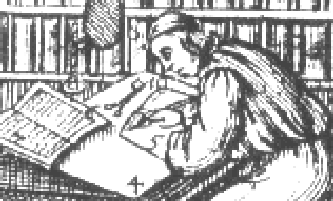 |
Text Encoding Initiative |
The XML Version of the TEI Guidelines<join> |
| <join> | identifies a possibly fragmented segment of text, by pointing at the possibly discontiguous elements which compose it. | |
| Attributes | (In addition to global attributes and those inherited from metadata, pointer) | |
| Example |
The following example is discussed in section 14.7 Aggregation: <sp who="hughie"><p>How does it go?
<q><l id="x1">da-da-da</l>
<l id="l2">gets a new frog</l>
<l>...</l>
</q></p></sp>
<sp who="louie"><p><q><l id="l1">When the old pond</l> ...</q></p></sp>
<sp who="dewey"><p><q>... <l id="l3">It's a new pond.</l></q></p>
<!-- ... -->
<join targets="l1 l2 l3" result="lg" desc="haiku" scope="root"/>
</sp>
The attribute targOrder is specified with a
value of Y to indicate that the order of the three
lines is significant. The attribute scope is
allowed to take the default value of root to
indicate that the virtual element being identified is a line
group (<lg>) which contains the three <l>
elements L1, L2, and L3, and not just their character data
content.
|
|
| Example |
In this example, the attribute scope is specified with the value of branches to indicate that the virtual list being constructed is to be made by taking the lists indicated by the targets attribute of the <join> element, discarding the <list> tags which enclose them, and combining the items contained within the lists into a single virtual list: <p>Southern dialect (my own variety, at least) has only
<list id="LP1">
<item><s>I done gone</s></item>
<item><s>I done went</s></item>
</list> whereas Negro Non-Standard basilect has both these and
<list id="LP2">
<item><s>I done go</s></item>
</list>.</p>
<p>White Southern dialect also has
<list id="LP3">
<item><s>I've done gone</s></item>
<item><s>I've done went</s></item>
</list> which, when they occur in Negro dialect, should probably
be considered as borrowings from other varieties of English.</p>
<!-- ... -->
<join result="list" id="LST1" targets="LP1 LP2 LP3" scope="branches"
desc="Sample sentences in Southern speech"/>
|
|
| Module | Declared in file teilink2.dtd; Additional tag set for Linking and Segmentation: enabled by TEI.linking | |
| Class | pointer; metadata | |
| Data Description | Empty element. | |
| May occur within | ab abbr activity actor add addName addrLine address admin affiliation analytic app argument author authority back bibl biblFull biblScope biblStruct birth bloc body byline camera caption case castGroup castItem castList cell channel cit cl classCode closer colloc constitution corr country creation damage date dateRange dateStruct dateline def del derivation descrip dictScrap distance distinct distributor div div0 div1 div2 div3 div4 div5 div6 div7 docAuthor docDate docEdition docImprint docTitle domain edition editor education emph entry entryFree epigraph epilogue etym expan extent factuality figDesc figure firstLang foreName foreign form front funder fw gen genName geogName gloss gram gramGrp graph group head headItem headLabel hi hyph imprimatur imprint interaction item itype joinGrp l label lang langKnown language lbl lem lg lg1 lg2 lg3 lg4 lg5 list listBibl locale m measure meeting mentioned metDecl monogr mood name nameLink note num number occasion occupation offset ofig opener orgDivn orgName orgTitle orgType orig orth otherForm p per performance persName phr placeName pos preparedness principal prologue pron pubPlace publicationStmt publisher purpose q quote rdg rdgGrp re ref reg region rendition residence resp respStmt restore role roleDesc roleName row rs s salute seg sense series set settlement sic signed soCalled socecStatus sound sp speaker sponsor stage street stress subc supplied surname syll symbol table tagUsage tech term termEntry text tig time timeRange timeStruct title titlePage titlePart tns tr trailer trans u unclear usg view w wit witDetail witList witness writing xr xref | |
| Declaration |
<!ELEMENT join %om.RO; EMPTY>
<!ATTLIST join
%a.global;
%a.pointer;
targets IDREFS #REQUIRED
result CDATA %INHERITED;
desc CDATA %INHERITED;
scope (root | branches) "root">
|
|
| See further | 14.7 Aggregation | |
Up: 35 Elements